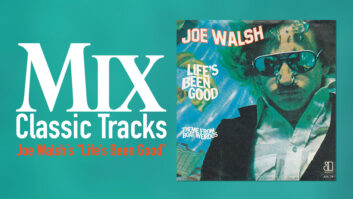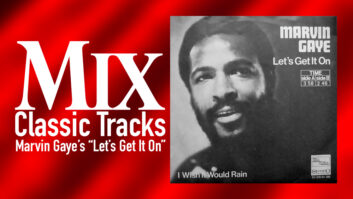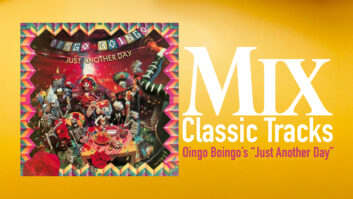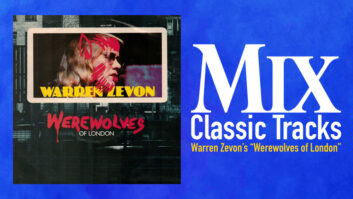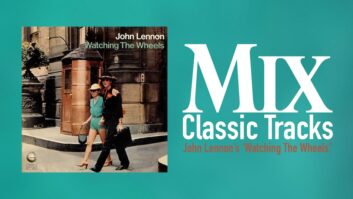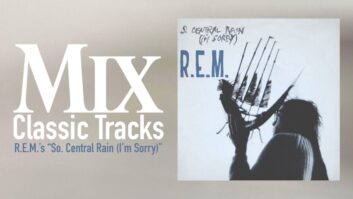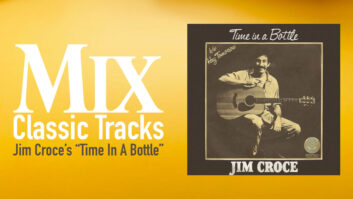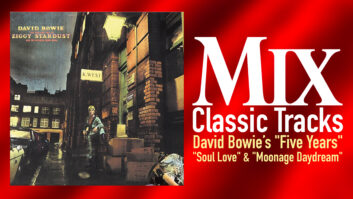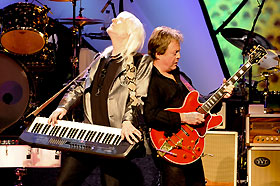
Edgar Winters (left) still plays “Frankenstein” during his concerts; Rick Derringer is at right.
Photo: Rob Shanahan/robshanahan.com
Alhough multi-instrumentalist Edgar Winter originally had strong interests in science and engineering, the success of his blues-minded brother, Johnny Winter, changed that. At Johnny Winter’s behest, Edgar Winter played on his brother’s albums and performed in gigs in between sets at his brother’s shows.
In between some blues numbers, Winter worked in one of his new tunes, an instrumental to act as a showcase. The song had a distinctive riff at its center, which would later become the signature of “Frankenstein.” “It didn’t really have a name, but we started calling it ‘The Double-Drum Song’ because we had two complete drum sets onstage, and I would do a dual drum solo with Johnny’s drummer, Red Turner.” Winter played “The Double-Drum Song” around the world and it was forgotten—until 1971, when Winter wandered into Manny’s Music in New York City and spotted an ARP 2600 synthesizer. “As a keyboardist, I had always been frustrated,” he says. “You could never mike an acoustic piano well enough to hear it against the guitars and you were locked down in one place.”

The ARP 2600 appealed to Winter. It was connected to the base unit by a single umbilical cord as compared to Moog’s keyboard, which had to stay at the base. “When I saw it in Manny’s, I said, ‘Whoa, look at that keyboard. That’s pretty lightweight. Looks like you could just put a strap on it and play it like a guitar. The first night I walked out onstage and put on the synthesizer, the crowd went wild. It was just one of those rock ’n’ roll moments.”
Winter needed a tune that would showcase his new instrument so he turned to his old favorite. “I thought, ‘I’ll bet that riff in that old ‘Double-Drum Song’ would sound really great, with that reinforced subsonic synth bottom.’ We tried it out, and it was just killer.”
Over a period of a month, Winter studied and explored the ARP with the help of synth guru Bob Margouleff, with whom he traded piano lessons for synth lessons. “A lot of people at that time used the synth simply to emulate the sounds of already-existing instruments,” Winter says. “My approach was to introduce the synthesizer as a lead instrument. I wanted to use it to create never-before-heard sounds.”
Winter was like the proverbial kid in a candy store with his new tool as he applied it to the “Double-Drum” piece. “The song just kept getting longer and longer. Each time I would create a sound, I would make a new section of music to incorporate that sound.” Eventually it became a 15-minute favorite that closed every show. “Finally, I could play this keyboard and do it in a new and interesting way, where people can actually see my hands and see what I’m doing,” Winter says. “It was an amazing sense of freedom, and it created such an impact.”
About that time, in 1972, Winter brought a new group of musicians, dubbed the Edgar Winter Group—replacing his previous band, Edgar Winter’s White Trash—into the studio to record. Winter had formed the new group with guitarist Dan Hartman, hoping to take advantage of the duo’s songwriting prowess. They added guitarist Ronnie Montrose, bassist Randy Jo Hobbs and drummer Chuck Ruff, brought in by Montrose.
The Edgar Winter Group recorded two songs: “Free Ride” and “We All Had a Real Good Time.” The former featured Johnny Badanjek on drums and Hartman playing the song’s signature guitar riff. But Winter quickly decided that a quartet would be less unwieldy than a quintet. “It just seemed like with four people, it was easier for the audience to focus on all the individual members,” Winter says. So Hobbs left, with Hartman shifting to bass, leaving Montrose as the group’s sole guitarist.

Producer Rick Derringer had worked with both Badanjek and Winter, including both White Trash albums. Derringer would also produce the new recordings, which would result in the first Edgar Winter Group album, They Only Come Out at Night. Derringer brought in producer/engineer Bill Szymczyk to engineer the album. The two had first worked together on Derringer’s All American Boy album (which would be released two years after Night).
The group booked time at New York’s The Hit Factory. “The place was built and owned by Jerry Ragavoy, who is a great producer/songwriter, and who is the guy that taught me how to produce records,” Szymczyk says. Derringer had also recorded there with The McCoys. The control room featured a custom console, which Derringer describes as “somewhere between an API and a Trident.” Derringer and Szymczyk recorded They Only Come Out at Night onto 2-inch tape using an Ampex 1000 16-track tape machine.
Montrose was set up with his Les Paul and Marshall amp to the left, with Hartman playing a Fender Precision further to the far left, as Szymczyk recalls. Ruff’s drum kit—a Ludwig with a single rack tom and two floor toms—was gobo’d off in the far-right corner. The guitar amp was miked at the cone, though typically pulled back by about a foot or foot-and-a-half, Szymczyk notes. “The louder they were, the further away I’d go. And it wasn’t to protect microphones and diaphragms; it was to get more of the room.” Eight mics covered the drums, bused to four channels to save tracking space. The bass was recorded both direct and miked at the amp, though the guitar was strictly miked. Winter’s ARP was recorded direct and miked at amp.
Derringer recalls, “Bill and I were aware of how well [‘The Double-Drum Song’] went over every time Edgar played it. We were both very into the idea of recording it.” Winter’s label, Epic, was also aware of the piece’s popularity, but didn’t want it on the album. “Some record company reps came to us in the studio, and said, ‘We’ve been thinking about it and this instrumental song may not fit on this album really well; all this stuff’s vocal stuff and pop-sounding, and this far-out-sounding instrumental.’” But to Derringer and Szymczyk, “The Double-Drum Song” was the one they had been most excited to record. “So we told them, ‘I guess we can all talk about it when it’s done, but we’re gonna record the song,’” Derringer says. At least three full takes of the still-unnamed track (“Double-Drum” was just a nickname) were recorded live. All three takes were quite lengthy, varying from about 11 to 15 minutes each.
Winter played his ARP in the studio as he had onstage, moving around with his keyboard attached. He also switched between the ARP’s various patches. The main patch—which Winter used for the song’s signature riff, as well as its bass line and solo—became known as “Frank Solo.” The sound was played straight for most of the song, although Winter used a wah-wah pedal through the solo. For the song’s 6/8 section, Winter used another patch he donned “Acid Bath,” which was just a square wave modulating. Another signature patch, heard about three-quarters of the way through the song, “was done by changing the filter resonance while turning the ARP’s internal clock to give it that pulse,” Winter says. To give the ARP an added stereo effect on the recording, Szymczyk used a device called The Cube. “Bill had this little thing you would plug into that created this little boxy, small-room sound,” Derringer says. “We put Edgar’s main sound on one channel, and then also put it through the Cube and [brought] the processed sound up on the other channel. Coincidentally, the two [sounds] fit together like cogs in a wheel, creating this amazing stereo effect.”
The band performed live for the recording, except for the drum tradeoff, which was recorded as an edit piece and inserted into the master. “Originally, when I played that with Johnny’s band, we had two drum kits,” Winter says. “But that was so problematical onstage, I switched to timbales for the recording. And there’s a part of the drum solo I wanted to make certain had a stable timing, so we did that to a click track.”
Once the song was tracked, Szymczyk edited together the best parts of each take by cutting the original 2-inch multitrack tapes. “That’s what was done in those days,” Winter says. “You could work from a safety [copy], but then you’d have generational losses.”
As Szymczyk recalls, “Rick said, ‘Well, we’re gonna cut it like it is, and then we’ll start slashing.” He marked the tape with a china marker and cut. “If it didn’t work, you’d just put it back.” The main idea was to keep representative portions of each musical section of the song. “There were sections that were, like, ‘Well, we gotta have some of this, we gotta have some of this, we gotta have some of that.’ I remember getting it down from 10 or 11 minutes to about seven minutes. And there were nice, really smooth transitions.”
After Szymczyk completed the edit, Winter added the track’s one overdub, playing a second guitar part during the song’s jazzy interlude to create a three-part harmony with the saxophone he had played live during tracking. Clocking in at more than seven minutes, the song was too unwieldy to fit on the disc and was unlikely to be played on the radio. So yet another round of edits took place, this time with the team working from the 2-track stereo mix, with pieces of tape scattered everywhere throughout the control room. “It was a long, laborious, tedious and sort of agonizing process,” Winter says. “It was sort of like cutting a diamond.”
Derringer recalls: “What we had to do was take each section and whittle that section down to its smallest possible length that would still represent what that section was about. The idea was to try to retain the integrity of the whole song.” The team came up with an acceptable edit of 4:45 in length. “I just said, ‘That’s as much as I can take out and still have the song be what it was intended to be, and have it be musically flowing and intelligible,” Winter recalls. The edit, Szymczyk says, holds up quite well to this day. “I was listening to it the other day, trying to play a ‘spot the edit’ game. [Laughs] I found a few. But there are a whole lot more that went by pretty cool.”
Once completed, everyone listened to a playback. “As the tape was rewinding,” Winter recalls, “Chuck was watching, kind of in a hypnotic state, and seeing all those edits go by. And he mumbled the immortal words: ‘Wow, man, it’s like Frankenstein.’ I wasn’t sure about the negative connotations involved with the monster. But the more I thought about it, the more perfect it felt. The whole idea of Frankenstein was technology running amuck, with me as the doctor, and the song itself, the creation, as the Monster. It took a few minutes to sink in, then but I said, ‘Yeah! That’s it.’ So the monster was born!” Radio stations began playing “Frankenstein” in their own crudely edited versions to cut it down to size. Derringer, Szymczyk and an Epic A&R rep returned to The Hit Factory for another round of edits, this time without Winter, creating an acceptable edit length of 3:28.
“Frankenstein” remains a favorite of Winter’s: “I still love to blast it, and I still enjoy playing that song every bit as much as I did when we first started playing it live.”
